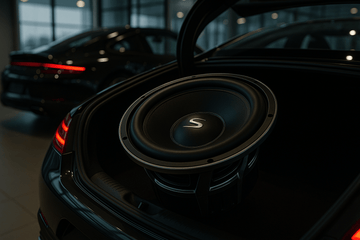What is a Subwoofer? Your Complete Guide
Discover everything about subwoofers - from how they work to choosing the perfect one for your car or home audio system.
A subwoofer is a speaker designed to reproduce low-frequency sounds, typically between 20-200 Hz. These powerful speakers handle the deep bass that regular speakers cannot produce effectively. Understanding what is a subwoofer helps you make better choices for your audio system.
How Does a Subwoofer Work?
What is a subwoofer's working principle? A subwoofer uses a large driver (speaker cone) and powerful magnet to move air and create low-frequency sound waves. The larger the cone, the more air it can move, producing deeper bass.
Key Components
- Driver: Large cone that moves air
- Magnet: Creates electromagnetic field
- Voice Coil: Converts electrical to mechanical energy
- Enclosure: Controls air movement and sound quality

Types of Subwoofers
Active Subwoofers
Active subwoofers have built-in amplifiers, making installation easier. When considering what is a subwoofer for your car, active models are often the best choice for beginners.
Passive Subwoofers
Passive subwoofers require external amplification but offer more flexibility and power potential. Understanding what is a subwoofer's power needs helps you match it with the right amplifier.
Subwoofer Sizes and Their Impact
When learning what is a subwoofer's optimal size, consider your space and bass preferences. Larger subwoofers move more air and produce deeper bass, while smaller ones fit better in tight spaces.
Subwoofer Enclosure Types
Sealed Enclosures
Understanding what is a subwoofer enclosure's impact on sound is crucial. Sealed boxes provide tight, accurate bass with excellent transient response, perfect for music that demands precision.
Advantages:
- • Tight, controlled bass
- • Smaller enclosure size
- • Better transient response
- • Easier to design
Best For:
- • Rock and metal music
- • Limited installation space
- • Accurate sound reproduction
- • Beginner installations
Ported Enclosures
Ported boxes use a tuned port to enhance efficiency and output. When considering what is a subwoofer's maximum potential, ported enclosures often provide louder bass with less power.
Advantages:
- • Higher output levels
- • More efficient design
- • Enhanced low-frequency response
- • Better power handling
Best For:
- • Hip-hop and electronic music
- • Competition systems
- • Maximum volume applications
- • Home theater systems
How to Install a Subwoofer
Now that you understand what is a subwoofer, let's cover installation. Proper installation ensures optimal performance and prevents damage to your audio system.
Installation Steps
- 1 Choose the right location for your subwoofer
- 2 Connect power wire from battery to amplifier
- 3 Run RCA cables from head unit to amp
- 4 Install ground wire to metal chassis
- 5 Connect subwoofer to amplifier outputs
- 6 Tune amplifier settings for optimal sound
Pro Installation Tips
- • Use proper gauge wire for power connections
- • Secure all wiring away from heat sources
- • Install fuse within 18 inches of battery
- • Test all connections before final assembly
- • Break in new subwoofers gradually

How to Choose the Right Subwoofer
Selecting the perfect subwoofer depends on your specific needs. Understanding what is a subwoofer's role in your system helps you make the right choice for your budget and space.
Budget Considerations
Set a realistic budget including amplifier, wiring, and installation costs
- • Entry level: $100-300
- • Mid-range: $300-800
- • High-end: $800+
Space Requirements
Measure your available space and consider enclosure size
- • Trunk space available
- • Under-seat options
- • Custom installations
Music Preferences
Different music styles benefit from different subwoofer characteristics
- • Rock: Sealed enclosures
- • Hip-hop: Ported boxes
- • Classical: Accuracy focused
Quick Selection Guide
For Beginners:
- Start with 10" active subwoofer
- Choose sealed enclosure for simplicity
- Focus on reputable brands with good support
For Advanced Users:
- Consider multiple subwoofer setups
- Experiment with custom enclosure designs
- Match subwoofers with high-quality amplifiers
Common Subwoofer Mistakes to Avoid
What NOT to Do
- × Overpowering subwoofers beyond their ratings
- × Installing without proper fusing
- × Using undersized power wire
- × Ignoring impedance matching
- × Poor ground connections
Best Practices
- ✓ Match amplifier power to subwoofer ratings
- ✓ Use quality wiring and connections
- ✓ Properly tune crossover settings
- ✓ Test system before finalizing installation
- ✓ Break in new equipment gradually
Need Professional Help?
Understanding what is a subwoofer is just the beginning. Professional installation ensures optimal performance and protects your investment.
Find Installation ServicesFrequently Asked Questions
What is a subwoofer's ideal placement in a car?
The trunk is typically the best location for subwoofers, providing adequate space and isolation. However, under-seat subwoofers work well in smaller vehicles where trunk space is limited.
How much power does a subwoofer need?
Most car subwoofers perform well with 150-500 watts RMS. Match your amplifier's RMS output to your subwoofer's RMS rating for optimal performance and reliability.
Can I install multiple subwoofers?
Yes! Multiple subwoofers can increase output and improve bass distribution. Ensure your amplifier can handle the combined impedance load and power requirements.
Learn About Subwoofer WiringWhat's the difference between sealed and ported boxes?
Sealed boxes provide tight, accurate bass, while ported boxes offer louder output and enhanced low-frequency response. Your music preferences and space constraints determine the best choice.
Complete Your Audio System

Car Amplifiers
Power your subwoofers with quality amplifiers designed for optimal performance and reliability.
Shop Amplifiers
Wiring Kits
Professional-grade wiring kits with everything needed for safe, reliable subwoofer installations.
Browse Wiring
DSP Processors
Fine-tune your system with digital signal processing for perfect sound quality and integration.
Explore DSPReady to Transform Your Audio Experience?
Now that you understand what is a subwoofer and how it can enhance your audio system, it's time to choose the perfect one for your needs. Our expert team is here to help you make the right decision.





